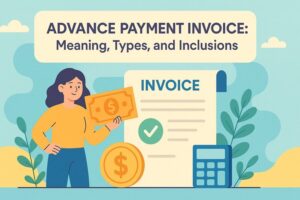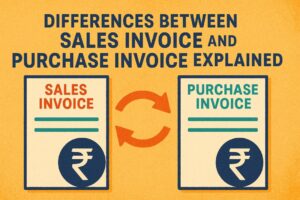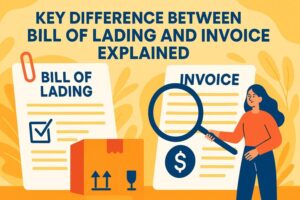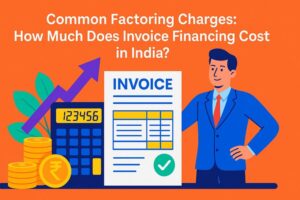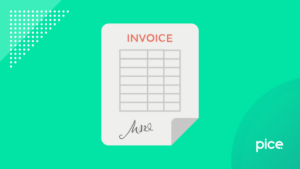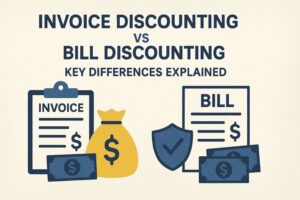E-Invoicing Under GST: Who Needs It, How It Works, and Latest Turnover Limit
- 13 Nov 25
- 12 mins
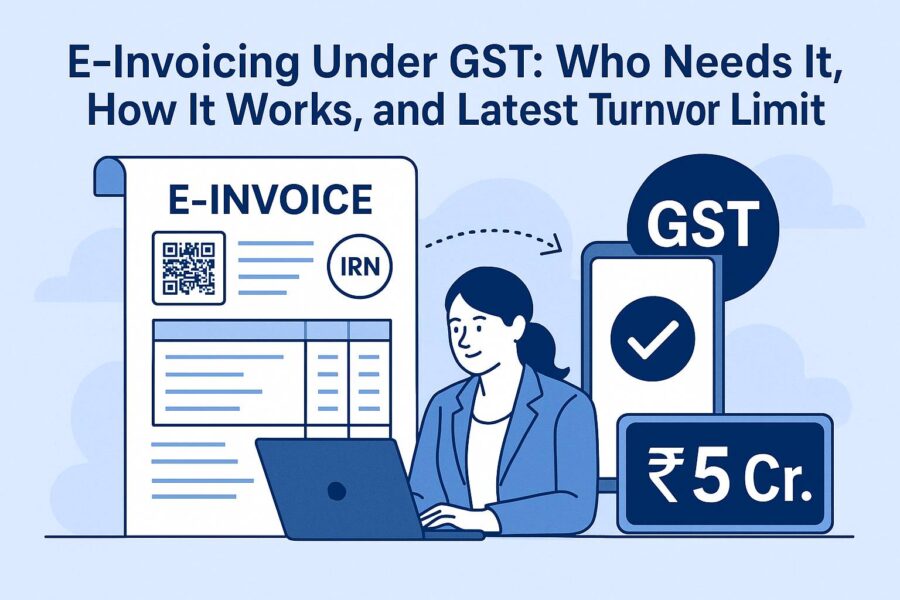
E-Invoicing Under GST: Who Needs It, How It Works, and Latest Turnover Limit
- Everything You Need to Know About e-Invoicing Under GST
- Why Was E-Invoicing Introduced?
- Who is Required to Generate an e-Invoice and Its Applicability?
- Breakdown of e-Invoice Format and Required Details
- 7 Key Benefits of e-Invoicing Under GST
- Transactions and Documents Covered by E-Invoicing
- Exemptions: Who Is Not Required to Use E-Invoicing?
- How Can e-Invoicing Restrict Tax Evasion?
- When Should the e-Invoice Time Limit be Generated?
- What is the Time Limit for Generating an e-Invoice?
- The E-Invoice Generation Process: Step-by-Step Guide
- Practical Example: E-Invoicing in Action for SMEs
- 6 Common Mistakes to Avoid While Generating E-Invoices
- Conclusion
Key Takeaways
- E invoicing under GST is mandatory for businesses with turnover above ₹5 crore, ensuring stronger compliance and error-free reporting.
- Invoices are not created on the GST portal; instead, they are uploaded to designated Invoice Registration Portals (IRPs) for authentication.
- Once validated, an IRN and QR code are generated, enabling seamless auto-population of GST returns and e-way bills.
- E invoicing under GST enhances transparency by reducing fake invoices, improving ITC accuracy, and supporting real-time tracking.
- Timely generation and reporting of e-invoices is essential to avoid penalties, especially for businesses crossing new turnover thresholds.
Did you know that over 90% of GST-registered businesses with a turnover of over ₹5 crore are now required to generate e-invoices? If you are still unsure whether your business falls under the latest mandate, it is time to pay attention.
E-invoicing under GST is not just a technical shift but a major step toward better compliance, faster reconciliation, and reduced errors. As the government continues to lower the threshold for applicability, staying informed can help you stay ahead. Whether you run a growing enterprise or handle B2B or export transactions, this update could directly impact your invoicing process.
Let us explore what is new and what it means for you.
Everything You Need to Know About e-Invoicing Under GST
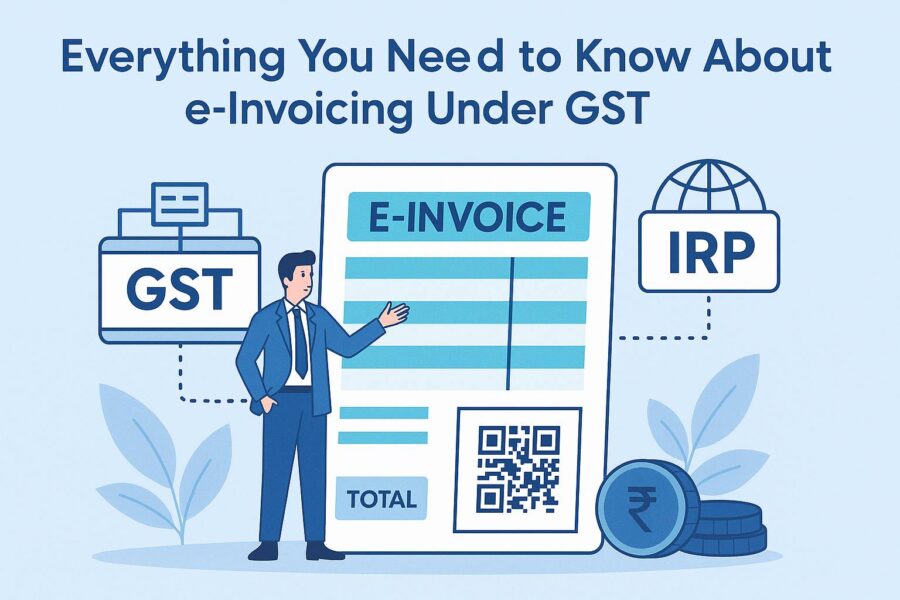
E-invoicing, or electronic invoicing, is a system in which B2B invoices and certain other documents are validated and authenticated electronically by the GST Network (GSTN) for use on the GST portal. Introduced following the 35th GST Council meeting, e-invoicing initially targeted large enterprises but has progressively extended to encompass medium and small businesses as well.
An important point to clarify - e-invoicing under GST does not entail generating invoices directly on the GST portal. Rather, it involves uploading a standard-format invoice to designated e-invoice portals (IRPs) notified by the Central Board of Indirect Taxes and Customs (CBIC), such as through Notification No. 69/2019 – Central Tax.
Every invoice submitted under this system receives an identification number (IRN) generated by the Invoice Registration Portal (IRP), which is managed by GSTN. Essential invoice data is automatically shared with other GST systems, removing the need for repetitive manual entry and streamlining processes for GST returns and e-way bills.
Why Was E-Invoicing Introduced?
The government instituted e-invoicing to:
- Reduce tax evasion by making every B2B transaction digitally traceable.
- Simplify the process of claiming Input Tax Credit (ITC) for buyers.
- Automate and pre-populate key GST forms and returns, thus reducing manual errors and discrepancies.
- Enhance tax compliance, leading to increased government revenue and efficient auditing.
Who is Required to Generate an e-Invoice and Its Applicability?
E-invoicing under GST is compulsory for GST-registered businesses whose annual aggregate turnover exceeds the notified limits. Thresholds have been gradually reduced as follows:
| Phase | Turnover Threshold | Effective Date | Notification Reference |
| I | ₹500 crore | 1 Oct 2020 | 61/2020 & 70/2020 – Central Tax |
| II | ₹100 crore | 1 Jan 2021 | 88/2020 – Central Tax |
| III | ₹50 crore | 1 Apr 2021 | 5/2021 – Central Tax |
| IV | ₹20 crore | 1 Apr 2022 | 1/2022 – Central Tax |
| V | ₹10 crore | 1 Oct 2022 | 17/2022 – Central Tax |
| VI | ₹5 crore | 1 Aug 2023 | 10/2023 – Central Tax |
The Annual Aggregate Turnover (AATO) is assessed collectively for all GSTINs linked to a single PAN at the national level, covering the financial years 2017–18 to 2021–22 for compliance in 2022–23.
Example Scenarios:
- XYZ Ltd recorded turnovers as follows: ₹14 crore (FY18), ₹16 crore (FY19), ₹22 crore (FY20), ₹26 crore (FY21), ₹18 crore (FY22). As it exceeded the previous turnover threshold in relevant years, e-invoicing was required from 1 April 2022.
- PQR Ltd, founded in FY19–20, crossed ₹10 crore in turnover in FY21–22, making it liable for e-invoicing from 1 October 2022.
Notes:
- If a business’s turnover surpasses the threshold during the current financial year, e-invoicing under GST is mandated from the beginning of the next financial year.
- The turnover limit includes all GSTINs nationwide under a single PAN, not per GSTIN.
Breakdown of e-Invoice Format and Required Details

E-invoices must comply with prescribed GST invoicing rules, containing crucial data fields and sections. As per Notification No. 60/2020 – Central Tax (dated 30 July 2020):
12 sections (5 mandatory, 7 optional) and 6 annexures (2 mandatory), distributing a total of 138 fields (only 30 of which are mandatory).
The 5 mandatory sections include:
- Supplier details
- Basic information
- Recipient details
- Item details
- Document details
Two mandatory annexes cover detailed item information and documentation.
Mandatory fields include the following:
- Type of document code
- Legal name of supplier (as per PAN)
- Supplier GSTIN and address
- Unique document/invoice number
- Invoice and document date
- Legal name and GSTIN of the recipient
- Detailed recipient and supply location info
- HSN code and item description
- Price (excluding GST), assessable value, and applicable GST rates
- SGST, CGST, IGST values
- Invoice reference number (generated by portal)
- Shipping, dispatch, and service tags
Please note that the original requirement of 50 fields has been trimmed to 30 mandatory core fields, streamlining compliance for businesses.
7 Key Benefits of e-Invoicing Under GST
- Reduced data reconciliation errors: Since invoices are centrally verified, discrepancies between GSTR-1 and GSTR-2A/2B are minimised.
- Real-time invoice tracking: Both suppliers and authorities can monitor transaction flows instantly.
- Interoperability: An e-invoice generated by one software system can be seamlessly read and accepted by another.
- Automatic input tax credit (ITC): Genuine ITC is more quickly and accurately credited to recipients.
- Automated GST return filing: E-invoicing data auto-populates key GST returns and e-way bill forms.
- Reduced audits: With enhanced transparency and readily available documentation, the likelihood of tax audits is diminished.
- Enhanced business reputation: Greater digital compliance enables small and medium businesses to deal with large corporate entities and government contracts.
💡If you want to streamline your payment and make GST payments via credit, debit card or UPI, consider using the PICE App. Explore the PICE App today and take your business to new heights.
Transactions and Documents Covered by E-Invoicing
Applicable Documents:
- Tax invoices
- Credit notes
- Debit notes (as per Section 34 of the CGST Act)
Applicable Transactions:
- B2B (business to business) and B2G (business to government)
- Deemed exports and exports (with or without IGST payment)
- Supplies to SEZ units and developers
- All supplies eligible under Section 9(3) of the CGST Act
- B2C (business-to-consumer) transactions remain exempt from mandatory e-invoicing.
What is Aggregate Turnover as Per GST?
The GST Act (Section 2(6)) defines ‘aggregate turnover’ as the total value of:
- Taxable supplies (excluding GST itself)
- Exempt supplies
- Exports of goods/services
- Inter-state supplies by a person with the same PAN
All supplies made under multiple GSTINs registered to the same PAN must be considered for the “aggregate turnover” calculation, not just each GSTIN individually. This sum is calculated across India and excludes taxes under SGST, CGST, UTGST, and IGST for the purpose of turnover.
Exemptions: Who Is Not Required to Use E-Invoicing?
Here is a list of registered individuals exempted from e-invoicing provisions:
- Individuals who completed e-invoice registration under Rule 14 of the CGST rules are exempted from e-Invoicing under GST.
- Any supplier of taxable services is excluded from e-invoicing applicability. This includes the banking company, insurer, financial institution, and other non-banking financial institutions.
- Any supplier of a goods transport agency offering transportation-related services by road.
- SEZ unit excludes electronic invoice; however, it does not exclude the SEZ developers.
- Suppliers who are responsible for supplying passenger transportation services are exempt from the applicability of e-invoicing.
- Excludes any registered individual responsible for offering services through admission to the exhibition of cinematograph films cast on multiplex screens.
- Any government functioning department or a local authority is also exempted from electronic invoicing under GST.
How Can e-Invoicing Restrict Tax Evasion?

E-invoicing strengthens India’s effort to curb fraudulent GST practices in several critical ways:
- Real-time access: Tax authorities receive immediate visibility of all transactions, blocking the window for manipulative behaviour and fraud.
- Fake invoice deterrence: All invoices must be pre-authenticated by the GST portal, limiting illegitimate ITC claims.
- Reduced manual errors: Routine entry errors and risks of intentional data manipulation are reduced as invoice validation takes place upfront.
When Should the e-Invoice Time Limit be Generated?
Timing is crucial when it comes to considering e-invoices. As per GST rules:
- Generate e-Invoices before the issuance of the final tax invoice to respective customers.
- If goods should be shipped, create the e-Invoices before dispatching.
- Missing the deadline for e-Invoice can cause penalties, and the invoice will be invalid.
So, it is beneficial to issue e-Invoices in real time or as early as possible after sale.
What is the Time Limit for Generating an e-Invoice?
There was no specific time limit for e-invoice generation until 30th April 2023. The government later announced generating e-invoices for tax invoices and credit debit notes within 7 days from the date of issuance of an invoice. This is, however, effective from 1st May, 2023, and applicable specifically for taxpayers with an Annual Aggregate Turnover (AATO) of ₹100 crore or more. Despite this announcement, the seven-day time limit was kept on hold.
Later on, starting 1st November 2023, the government made it mandatory for businesses to report tax invoicing, credit, and debit notes to any notified IRP within 30 days of issuing e-invoices. Businesses with an AATO of ₹100 crore must follow this.
Furthermore, the GSTN portal extended the 30-day reporting requirement and made it eligible for taxpayers with an AATO of ₹10 crore and more. For smooth compliance, this change became effective from 1st April, 2025.
The E-Invoice Generation Process: Step-by-Step Guide
Here is a detailed process to follow for obtaining an e-invoice:
Step 1: The individual taxpayer must ensure use of a reconfigured ERP system following PEPPOL standards. The taxpayer can also consult a software service provider for guidance about the standard set of e-invoicing.
Step 2: Two options made available to any taxpayer for easy generation of the IRN include:
- The IP address allows easy access to the e-invoice portal for direct integration of API or through the GST Suvidha Provider (GSP).
- Download the bulk generation software. Uploading bulk invoices here generates a JSON file for uploading to the official e-invoice portal, allowing you to generate IRNs in bulk.
Step 3: The taxpayer can then upload a regular invoice on that particular software. It is mandatory to provide the relevant details, including billing name, address, supplier's GSTN, item rate, value of transaction, applicable GST rate, tax amount, etc.
Step 4: Once you have completed choosing any of the above options, make sure to raise an invoice to the respective billing software or ERP software. After this, continue uploading your invoice details onto the IRP using a JSON file or through an application service provider. IRP here acts as the central registrar for e-invoicing. Other preferred modes of interacting with IRP include SMS and mobile applications.
Step 5: IRP validates essential details of the B2B invoice, checks for further duplications, and provides an invoice reference number. The four key parameters to follow to generate IRN include invoice number, GSTIN of seller, type of document (INV/CN/DN), and FY in YYYY-YY.
Step 6: IRP produces the invoice reference number (IRN), signs the invoice digitally, and produces a QR code for the supplier. On the other hand, the seller is informed about the generation of the e-invoice through email (if mentioned in the invoice).
Step 7: Further, the IRP sent out the e-invoice through e-mail, including the invoice to both the buyer and seller.
Practical Example: E-Invoicing in Action for SMEs
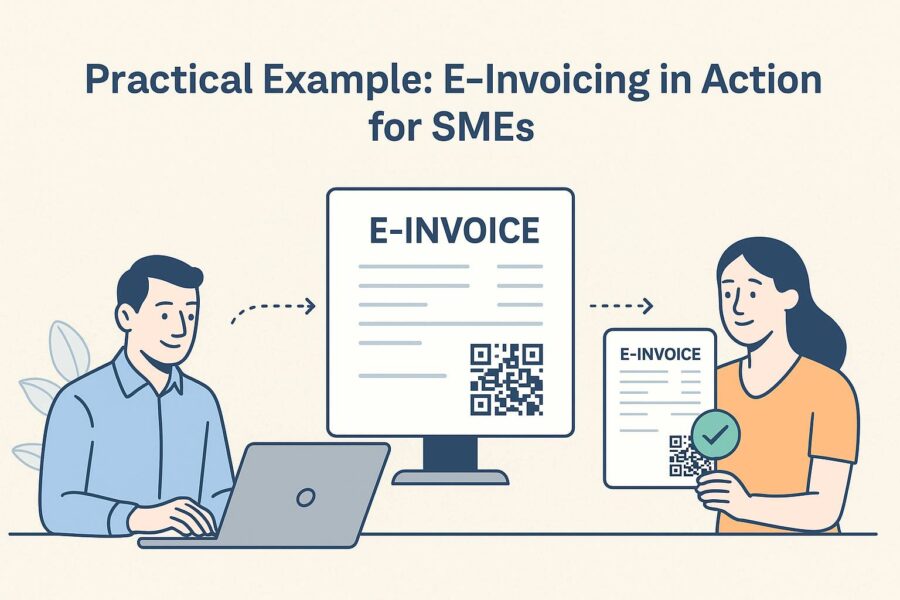
Imagine a medium-sized manufacturer, Sunrise Textiles, with a turnover of ₹15 crore in FY2022–23. Under the latest changes, as of 1 August 2023, the company must generate e-invoices for all B2B sales.
- All invoices are prepared through an e-invoice-enabled ERP.
- The ERP sends invoice details in real time to the IRP.
- The IRP validates and sends back the IRN and QR code.
- Sunrise Textiles can now share the e-invoice instantly with its buyers and pre-populate its GST returns, minimising the chances of ITC rejection or compliance failure.
6 Common Mistakes to Avoid While Generating E-Invoices
Implementing e-invoicing under GST streamlines compliance, but businesses must be vigilant to avoid errors that can lead to penalties or rejection. Here are typical mistakes and best practices to steer clear of them:
- Incorrect or Incomplete Data Entry
Mistakes in supplier/recipient GSTIN, address, HSN/SAC codes, or invoice amounts can render e-invoices invalid. Always cross-check these fields before submission.
- Missing or Invalid Invoice Reference Number (IRN)
All e-invoices must carry a valid, system-generated IRN and QR code. Manually created or altered invoices may not be accepted by the GST portal or customers.
- Uploading Invoices on the Wrong Portal
E-invoices must be generated through designated Invoice Registration Portals (IRPs), not directly on the GST return portal. Using the wrong portal can delay GST returns and ITC claims.
- Late Generation or Non-Compliance with Timelines
Generating e-invoices after dispatch or delayed reporting beyond the stipulated 30-day window (for businesses over ₹10 crore turnover from April 2025) can attract hefty penalties and lead to invalid invoices.
- Incorrect Document Type Selection
Confusing credit notes, debit notes, and tax invoices can create compliance issues. Select the correct document type code as specified in the latest notifications.
- Neglecting System/Software Updates
Using outdated ERP or billing systems may result in non-compliant invoices. Regularly upgrade your invoicing software to match evolving GST requirements.
Conclusion
E-invoicing under GST is a cornerstone in India’s digital tax compliance regime, paving the way for simplified, transparent, and error-free business administration. With the applicability threshold now at ₹5 crore, mid-sized enterprises must adapt quickly to avoid penalties and disruption.
On the horizon, it is expected that even smaller businesses may come under the e-invoicing fold as the government furthers its efforts to curb GST evasion.
The most prudent approach for all businesses, regardless of current applicability, is to update their systems, educate their teams, and stay up to date with GST notifications. Proactive preparation will not only ensure compliance but also unlock competitive advantages through efficiency and improved client confidence.
 By
By 





